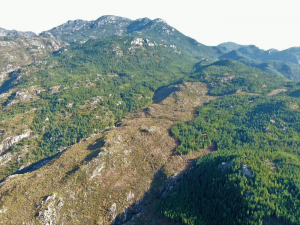A new research study highlights that catchment restoration can reduce the impact of human-driven climate change in mountainous regions.
New research, led by Dr Petra Holden from the African Climate and Development Initiative (ACDI) at the University of Cape Town (UCT), has shown how catchment restoration – through the management of alien tree infestation in the mountains of the southwestern Cape – could have lessened the impact of climate change on low river flows during the Cape Town ‘Day Zero’ drought.
Climate change is impacting extreme weather events such as droughts and floods. Nature-based solutions, such as catchment restoration, involve working with ecosystems and landscapes to address societal challenges. These challenges include the impacts of climate change on water resources. Up to now, studies have not yet separated the role of nature-based solutions in reducing the human-driven climate change impacts of extreme events on water availability from that of natural climate variability.
Water resource adaptation planning
Intending to inform water resource adaptation planning, this new study by an all-southern African based research team published in a Nature portfolio journal, Earth Communications & Environment, set out to do this foregrounding the Cape Town Day Zero drought as an example. The team’s focus was on a typical type of catchment restoration in South Africa – invasive alien tree management.
“Invasive alien trees have higher transpiration rates, compared to the native vegetation of the Cape mountains, and thus reduce streamflow,” Holden explained.
The research team combined climate models and a hydrological model to simulate streamflow during the ‘Day Zero’ drought. Following this, they tested how severe the hydrological drought would have been if there had been no human-driven climate change. For this, their focus was specifically on the impacts of climate change and alien tree management on streamflow from mountainous catchments that supply dams critical for water supply to Cape Town.

‘Day Zero’ drought
Holden explained: “Existing studies do not isolate the effect of nature-based solutions on the anthropogenically derived (i.e., human-derived) portion of climate change, especially for drought events that have already occurred. Few studies attribute biophysical impacts to human-caused climate change impact on drought events while simultaneously investigating the role of nature-based solutions in modulating this impact.”
This new analysis indicates that climate change reduced streamflow during the drought by 12% to 29% relative to a world without human-influence on the climate. Furthermore, it shows that clearing alien trees that were present in the catchments before the drought hit could have reduced the anthropogenic climate change impact on streamflow, but the effect was dependent on the extent of invasion.
Clearing moderate levels of invasion (such as 40% coverages seen in some catchments) would have resulted in a 3% to 16% amelioration of the human-derived climate change impact on streamflow. Preventing the spread of alien trees from current levels to full catchment invasion avoided additional reductions of 10% to 27% in streamflow due to anthropogenic climate change.
Climate change impact
The researchers also discovered that the impact of climate change was amplified due to catchment hydrological processes. For example, the reductions in streamflow (12% to 29%) were larger than the reductions in rainfall caused by anthropogenic climate change (7% to 15%). Despite the role that evapotranspiration can play in drought events, the researchers did not uncover a large impact of climate change due to evapotranspiration.
This is an important study for highlighting the power of quantitative assessments to inform climate change adaptation planning. The researchers were able to demonstrate that catchment restoration reduced the impact of anthropogenic climate change, but was not able to remove the full signal of human-driven climate change completely, even under current levels of climate warming.
Given this, the researchers stressed that it is critical to combine nature-based solutions with other adaptation strategies and options for water resource planning to combat accelerated climate change impacts.
“Teasing out the contribution of adaptation strategies – be they nature-based or not – for buffering society from human-driven versus natural variability in climate can be challenging. However, it is important to inform adaptation planning so that climate risk management strategies can be combined in ways that consider thresholds and limits to change,” concluded Holden.





